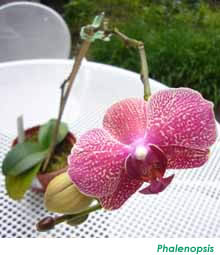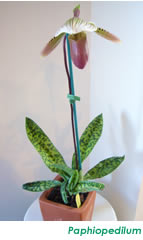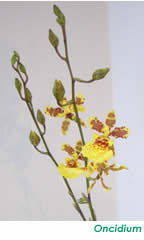| .. |
big
decorating
dreams. tiny
little
budget.
don't
be a wallflower! jump
on over to the discussion boards
and get decorating help.
|
| SiGN UP! join
the DigsNews mailing list + we'll keep you posted about updates and other DIGS-related news .
|
|
|
|
copyright ©1999-2006
DigsMagazine.com.
|
orchid you not easy
growing tips for orchid newbies
by Yee-Fan Sun | 1 2 3 4
continued from page 1
what
to buy
Orchids are unbelievably diverse, coming in all sorts of shapes and sizes and
colors. The orchid-obsessed will go to all sorts of lengths and plunk down crazy
amounts of cash for the rarest and more exotic varieties. But as an orchid newbie,
you’ll probably want to focus your potentials on the two least-fussy varieties:
Phalenopsis and Dendrobiums. Fortunately for your wallets, these are also the
most affordable, generally running between $14 and $25 a pot.
 Phalenopsis, otherwise known
as moth orchids, are not only hard to kill, but even neophyte orchid
gardeners should find it relatively easy to get them to bloom again
and again. They’re a great choice if your pad doesn’t get a whole
lot of light too, as they actually tend to do better in spots that
don’t get huge amounts of sunshine. In my old pad in Tucson, my north-facing
kitchen windowsill proved perfect; in less blazingly sunny climes,
a partly shaded east- or west-facing window, or a spot further back
from a south-facing window might all do the trick. Phalenopsis, otherwise known
as moth orchids, are not only hard to kill, but even neophyte orchid
gardeners should find it relatively easy to get them to bloom again
and again. They’re a great choice if your pad doesn’t get a whole
lot of light too, as they actually tend to do better in spots that
don’t get huge amounts of sunshine. In my old pad in Tucson, my north-facing
kitchen windowsill proved perfect; in less blazingly sunny climes,
a partly shaded east- or west-facing window, or a spot further back
from a south-facing window might all do the trick.
Common Dendrobium varieties,
on the other hand, require more sunlight, but if you have a bright
east or west-facing window or a filtered south-facing window, they’ll
do dandy if you pop them in the sill (in south or west-facing windows,
make sure the light isn’t so intense as to scorch the leaves; either
move the plant further back from the window, or add a sheer curtain).
Like Phalenopsis, they don’t require a whole lot of tending to keep
the foliage healthy; coaxing them into blooming, however, may be
slightly trickier.
 If you’ve had good luck with
the Phalenopsis and Dendrobium orchids and want to tackle something
just a lil’ more unusual, here are a few more varieties that you
should be able to find at a decent nursery, or occasionally even
retail stores. If you’ve had good luck with
the Phalenopsis and Dendrobium orchids and want to tackle something
just a lil’ more unusual, here are a few more varieties that you
should be able to find at a decent nursery, or occasionally even
retail stores.
Paphiopedilum | Also known
as slipper orchids -- as with Phalenopsis, they grow best in indirect
light; in fact you can get away with popping them in even dimmer
spots
Cymbidium | These are the big dramatic orchids you often see as cut blooms
in flower shops -- they like similar lighting conditions as Dendrobiums
Miltonia | Sometimes referred to as pansy orchids for their pansy-like blooms
-- give these indirect light, but a decent amount of it.
 My mom has also had good luck
with the pretty Jewel Orchid Ludisia discolor, which is common enough
that it sometimes turns up at Home Depot type places. Just give it
a window that gets good morning sun, or a filtered south or west-facing
spot. Many gardening magazines also recommend Oncidiums, though my
mom says that personally, she’s found them a little finicky. Still,
they’re very pretty -- sending up sprays of lovely little blossoms
-- and very easy to find. If you do want to give them a go, make
sure to give them a spot that gets plenty of light. My mom has also had good luck
with the pretty Jewel Orchid Ludisia discolor, which is common enough
that it sometimes turns up at Home Depot type places. Just give it
a window that gets good morning sun, or a filtered south or west-facing
spot. Many gardening magazines also recommend Oncidiums, though my
mom says that personally, she’s found them a little finicky. Still,
they’re very pretty -- sending up sprays of lovely little blossoms
-- and very easy to find. If you do want to give them a go, make
sure to give them a spot that gets plenty of light.
Whatever sort of orchid you
end up choosing, make sure that the leaves look firm and the color
good. Limp, yellowing or splotchy leaves may mean that the plant
hasn’t been well-nurtured. Roots, meanwhile, should be fleshy and
healthy, not shriveled.
motor
along for more...
--------------------------->
lounge . nourish .
host
. laze . home.
|
